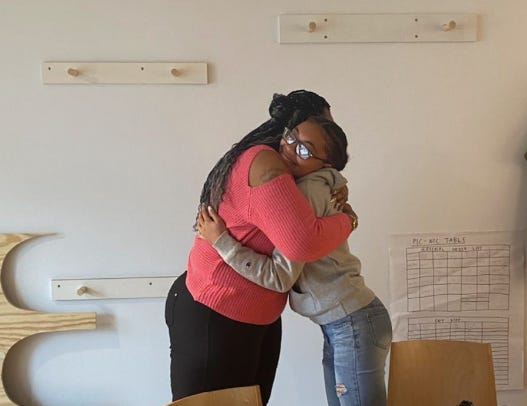Dear Starlight,
I am a commitment to Joy and Courage.
I release Conforming and Delusion.
May it be so.
As a lifelong student, a teacher with almost two decades of experience, and an organizational leader, I know to be true that we grow best in conditions where we feel aspiration. When our wills are aligned with the task or goal at hand, and we are encouraged, we move toward the future. Desire is always our guide.
But desire can be driven by fear. “I desire to be safe.” This makes sense. Wanting to be safe is a natural human condition in a world that is perilous. Yet what happens when fear defines the framework for growth? That is what I want to explore today—why it is imperative that we replace problem-solving and scarcity mindset with cultivating joy and abundance.
As the Executive Director of a nonprofit I created, I see firsthand how funders—philanthropists, state agencies, and foundations—approach their support. They claim to be solution-oriented, but in practice, they are problem-focused. Trust is built on metrics: Has the problem improved?
Over the last month, I’ve gathered materials to prove our program is improving youth disconnection. These metrics emphasize measurable outcomes like college admissions and workforce entry. Yet, I see clearly how problems grow from problems. If our funding depends on proving this narrow success, we’re incentivized to prioritize it for our institutional security—and the more significant, transformative work that is less tangible is lost.
Four years ago, our fellowship program relocated from a bucolic rural setting to an urban environment where most of the population lives under the poverty line, suffering from compounded systemic violence. The youth we serve shifted from privileged, educated youth to disconnected, undereducated youth.
Daily, our fellows contend with houselessness, domestic and sexual violence, racism, homicide, citizenship struggles, poverty, addiction, mental illness, and disability. These are not abstract terms; they are lived realities I witness daily through the resilience of these young people.
And yet, these systemic problems cannot be “fixed” in twelve months. True change requires liberating imaginations from trauma and oppression so these young people can envision their worth and creative possibilities and bring forth a new world. This magic takes time; generations.
As a child, I was raised in a complicated home. Picture a refrigerator with only a giant brick of American cheese, a box of Carnation dried milk, and a flimsy styrofoam carton of watery eggs—government-issued WIC food. My mother, with five children and no working income, insisted we never ask for more. My father, incapacitated by manic and depressive episodes, could not provide as he was either in his underwear on the couch or in the hospital.
I was taught not to want anything. Wants were selfish. Needs were shameful. At Christmas, we didn’t ask for toys but were coached to ask for oversized boots to last two years from the charity giving free holiday presents to families in need. I was supposed to be happy for the boots and ashamed to have secretly wanted something fun. My childhood left me believing my needs and desires were wrong to have.
In my early thirties, my first therapist caught this delusion. I had proposed teaching my Creativity + Courage curriculum for free, planning to work more as a private chef to cover costs. She asked: “Wouldn’t it be nice if you could work less cooking so you could teach more, since that’s what you want? How would you need to do that?”
That question cracked something open in me. I realized I’d undervalued myself and my desires—an ingrained belief that no one would pay for what I loved to offer. It’s true that I had already built some stability in my life as an entrepreneur, but the work I created for myself was work I thought others wanted and needed. It wasn’t work coming from a root of “what do I want to share from my own wellspring?” With my therapists support, I submitted my proposal as a paid job, and my life changed.
But the belief that my needs and wants don’t count is stronger than my belief that they do. This delusion still shows up, guiding my decisions in ways I don’t always see. It is often why I feel cinched at the waist, crippled in the hips, and tight in the back; I have unwittingly sacrificed my time and body for something unnecessarily so. (Devil card, my tarot buddies)
I believe we need to change our goal orientation away from solving problems and toward cultivating desires. Turn toward the good. What do we want more of, rather than what do we want less of? This is not an easy directional shift. Especially for anyone who has experienced trauma and oppression. In the Politics of Trauma by Staci K. Haines, Haines describes how trauma impacts our ability to express and recognize our desires.
Violation, neglect, and experiences of oppression tell us somatically that our being and our wholeness don’t or shouldn’t matter… Our survival reactions can tell us that all people are dangerous and that if we show what we care about, it will be used against us.
Sometimes, we will choose safety (not expressing our needs and desires) over another safety (living authentically). But this will cause diseased roots to spread unhealthy thinking and, therefore, our collective reality.
Funders want to solve problems. We want to solve problems. But when we focus solely on problems, we reinforce them. Instead, we must ask: How do we cultivate joy? How do we liberate imaginations and align young people and ourselves with our callings so we can authentically serve ourselves, our communities, and the earth? That work cannot be measured in twelve months, but it is the only work worth doing.
When a funder recently told me our program was “expensive,” my first reaction was shame. My delusional thinking wanted to cut the budget—to amputate something vital. But after a dark night of sweaty wrestling with my pillow, I woke up convinced to choose a different path. I am revisiting the budget, not to cut, but to expand. What areas need more? How can we better support our staff and fellows so their hearts and minds grow more capacity to love?
Imagine a nonprofit landscape (or any landscape) rooted in joy, aspiration, and creativity. Instead of measuring success by what we’ve fixed, we’d measure it by what beauty we’ve grown. Imagine programs that nurture the imaginations of young people, so they see themselves as valuable—capable of dreaming and building new, inclusive, thriving worlds.
Recently, I asked myself; how will I take radical responsibility of my power? My answer is by actively healing trauma so that I can improve my decisions that impact not only myself but those affected by them.
Practice is one way of embodying change.
Over the solstice, I created my life-affirming arrows; what I call towards me, and what I release for composting.
I am a commitment to Joy and Courage.
I release Conforming and Delusion.
I share them here so that you can be my encouraging witness as I step into practice; being my commitment.
PS. If you want to help Place Corps grow more good in the hearts, minds, and lives of youth disproportionately affected by systemic harm, please make an end-of-year tax-deductible donation and share the opportunity to help with others who can also help financially.










Wow! I am so amazed at your response (after tossing and turning) to “this is expensive” was to increase the budget. I know that the budget reflects concrete line items with actual dollar amounts, but the judgment that the funder made feels theoretical. If the receiver were someone else, how much would be reasonable? If the receiver were your child, or you, how much would be reasonable? What is the feeling of the environment created with X dollars vs XXX dollars? If you have spent time in places with those amounts of dollars doing the secret work of making things smooth, safe, comfortable, inspiring, then you know the difference between having them and not. Actually, I think safety is at the heart of it- how much does it take to feel safe & secure (for participants and staff, whole community), since only then can creation happen. Until that point, you can grind it out and make shit move, but nobody is feeling free.